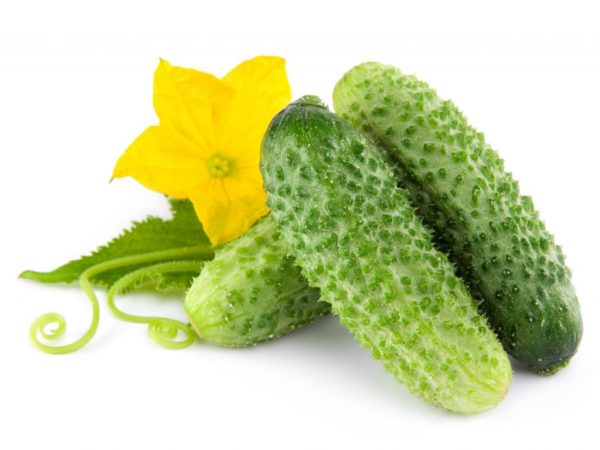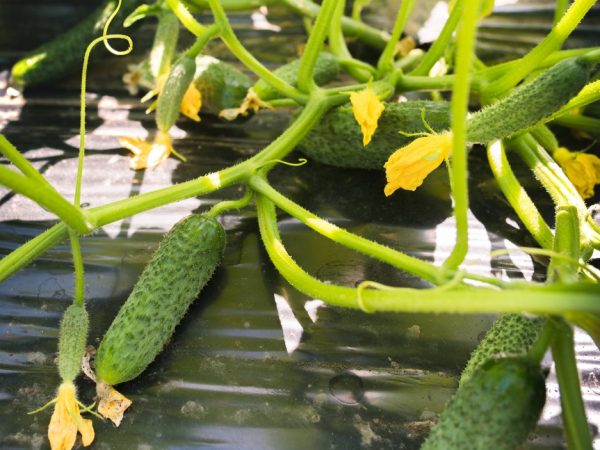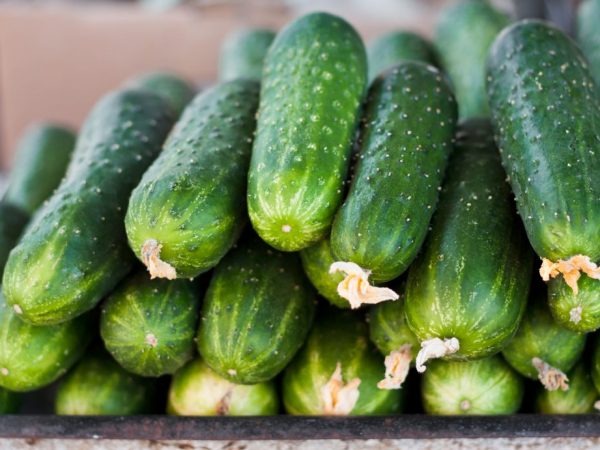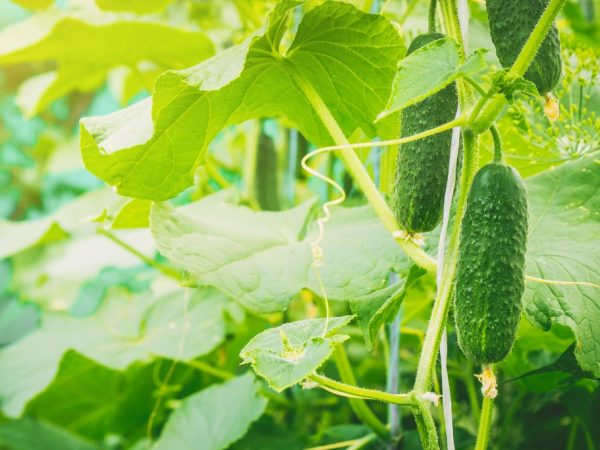The best varieties of gherkins
Gherkins are the best pickles for canning. They fit easily into even the smallest jar with a narrow neck. It is worth noting the high taste of pickled cucumbers. In this article, we will talk about gherkins, about the characteristics of the most popular varieties of mini-cucumbers.
- Parisian gherkin
- Description of the variety
- Advantages and disadvantages of the variety
- Micron F1
- Description of the variety
- Advantages and disadvantages of the variety
- Mels F1
- Description of the variety
- Advantages and disadvantages of the variety
- Novosibirsk gherkin F1
- Description of the variety
- Advantages and disadvantages of the variety
- Firestarter
- Description of the variety
- Advantages and disadvantages of the variety
- Moravian gherkin F1
- Description of the variety
- Advantages and disadvantages of the variety
- Patty
- Description of the variety
- Advantages and disadvantages of the variety
- Champion
- Description of the variety
- Advantages and disadvantages of the variety

The best varieties of gherkins
Parisian gherkin
This is an early ripe hybrid of French selection that can be grown both outdoors and in a greenhouse.
Description of the variety
A gherkin-type vegetable ripens in 45 days. In the open field, it is recommended for cultivation in central Russia. Ripe fruits are in the shape of a cylinder. Their length is on average 1-9 cm. On the surface of small cucumbers there are pronounced pimples, on the peel there are stripes of light green color. The average weight of one fruit is 70 g. From 1 sq. m, with proper care, 3-4 kg of fruits are harvested. During the fruiting period, cucumbers are harvested every day.
The Parisian gherkin is not self-pollinated. This makes it somewhat difficult to grow in a greenhouse. This variety is pollinated by insects, therefore, during the flowering period, it is necessary to ensure the presence of bees in the greenhouse.
There are manual methods of pollination that require a considerable investment of time: they collect pollen from male flowers with a brush and carefully transfer them to female ones. This is almost a piece of jewelry.
Advantages and disadvantages of the variety
Gherkins of this variety are valued for their high taste and good yield indicators. Another advantage of the variety is resistance to fungal diseases and high temperatures.
As for the shortcomings, cucumbers, when untimely harvesting, take the form of barrels. Since the Parisian gherkin is a hybrid variety, its seeds do not germinate well. Second generation hybrids are less productive and more susceptible to disease. Accordingly, seeds will have to be purchased every year in specialized stores.
Micron F1
This early ripe variety was bred not so long ago. It is recommended to grow it in a greenhouse.
Description of the variety
Under favorable conditions and proper care, Micron F1 yields a harvest already 38 days after planting. The bushes are medium-sized and medium-branched. The variety is pollinated by bees. The shape of the fruit, the weight of which varies from 60 to 80 g, resembles an ellipse. Their length is, on average, 8 cm. Pickles, the length of which does not exceed 4 cm, or mini-cucumbers 5 cm long, can be collected. The fruits have excellent taste. On the green peel there are pronounced pimples. From 1 sq. m collect up to 15 kg of cucumbers.Micron F1, due to its dense pulp structure, is suitable for canning and pickling.
Advantages and disadvantages of the variety
An important characteristic of Micron F1 is that it bears fruit throughout the summer. In addition, gherkin is resistant to almost all diseases. Micron is not prone to overgrowth, which makes harvesting easier.
There are no obvious flaws in the variety. The disadvantages of growing are associated with the need to pollinate the vegetable crop and purchase seeds from the store every year.
Mels F1

The variety is distinguished by its early maturity.
This hybrid is perhaps the most popular today. Its popularity is due to characteristics such as early maturity and yield. Gherkins of this variety can be grown both in greenhouses and in the open field.
Description of the variety
Mels F1 is an early ripe cucumber. It gives a massive harvest 35 days after planting, which is not typical even for early maturing varieties that begin to bear fruit closer to 38-39 days after planting. It is a self-pollinated plant, making it easy to grow in greenhouses.
This is a gherkin of a bouquet-type ovary. During flowering, several nodes appear on each branch, each of which gives up to 6 ovaries. During the fruiting period, more than 200 fruits are harvested from one plant. But such results can be achieved subject to the norms of agricultural technology, which include:
- timely landing in the ground;
- feeding the culture;
- watering and loosening.
The length of the cucumbers is, on average, 9 cm. In shape, the oblong gherkins resemble an elongated ellipse. The peel is green, pronounced pimples are covered with white fluff.
Advantages and disadvantages of the variety
The advantage of the Mels F1 variety is that its fruits, dense in structure, are never bitter. Mels F1 hybrid is resistant to various diseases and is not afraid of sudden changes in temperature. He, regardless of weather conditions, gives high yields.
No flaws were found in this hybrid variety.
Novosibirsk gherkin F1
It is a mid-season hybrid suitable for outdoor cultivation.
Description of the variety
The growing season of the plant is 45-49 days. The hybrid belongs to bee-pollinated. A medium-sized plant has long branches. The average weight of cylindrical fruits is 75 g. The average length of cucumbers is 10 cm, weight is 70 g. The rind is dark green, there are tubercles with small black thorns. In ripe cucumbers, the peel on the back turns yellow-green. From 1 sq. m collect about 5 kg. These are average yields. The yield of an ordinary variety Altai Waterfall, for example, is the same 5 kg.
Novosibirsk gherkins are suitable for making fresh salads and preserving. Crispy fruits with dense pulp are extraordinarily aromatic.
Advantages and disadvantages of the variety

It is important to prevent overripening of fruits.
The main advantage of the Novosibirsk gherkin is that it gives equally good yields in all weather conditions. The hybrid is resistant to fungal diseases, especially powdery and downy mildew.
Ripe fruits are prone to overripe, so they need to be picked every day. This is a disadvantage of the hybrid.
Firestarter
This is a bunch hybrid, the care of which requires the correct formation of the bush. For maximum results, the side shoots are removed, leaving a single stem.
Description of the variety
The growing season of the hybrid is 38-40 days. On the cucumber lashes of an early ripe hybrid, many greens are formed. After ripening, the length of cylindrical fruits is 9 cm, weight - 90 g. The peel is light green, white stripes are present. The aromatic and crunchy pulp never tastes bitter.
Cucumbers Perfection itself is used both for preparing fresh salads and for preserving. They can be picked unripe. Pikuli have the same taste as ripe fruits.
Advantages and disadvantages of the variety
The main advantage of the hybrid is its high yield. From 1 sq. m collect up to 30 kg of mini-cucumbers. The hybrid is resistant to changes in climatic conditions, with good watering it easily tolerates high temperatures. As for the disadvantages, these include the tendency to overripe.
Moravian gherkin F1
These are open field gherkins.
Description of the variety
The growing season of the bee-pollinated hybrid is 45 days. The first ripe cucumbers appear in 41 days. Bushes are tall, with short branches. In one internode, from 2 to 4 cucumbers are tied. Ripe cylindrical fruits have a length of 9 cm and a weight of 75 g. The peel is dark green in color. The yield of the Moravian gherkin hybrid is 6-7 kg per 1 sq. m. The crop is harvested daily. Most often the Moravian gherkin is used for rolling.
Advantages and disadvantages of the variety
The main advantages of the Moravian gherkin are disease resistance and independence from weather conditions. It produces equally good harvests in both hot and cold summers.
Patty

Patti is suitable for balcony cultivation
Self-pollinated hybrid Patti - a variety of breeders of the Moscow company Sedek. It can be grown not only on a personal plot, but also on a balcony.
Description of the variety
The growing season of a mid-season Patti hybrid ranges from 40 to 45 days. Ovaries in the sinuses are formed in bunches. Productivity - 24 kg per 1 sq. m, but this is an average figure. Subject to the norms of agricultural technology, the yield indicator reaches 37 kg per 1 sq. m.
The length of ripe cucumbers of a cylindrical shape is 10 cm, weight - 75 g. The peel is dark green, white pubescence is present, thorns are prickly. The fruit has a sweetish taste, the flesh is tender and moderately crunchy.
Advantages and disadvantages of the variety
According to the description, one of the main advantages of Patti is the high density of the pulp. The hybrid is also appreciated for its high yield and transportability.
Champion
This hybrid is adapted to the climatic conditions of Russia. It is suitable for cultivation even in the north of the country.
Description of the variety
This early maturing hybrid is suitable for outdoor cultivation. The length of ripe fruits varies from 10 to 12 cm, weight - 90 g. Gherkins are covered with a dark green skin, pubescence is practically absent. As for the taste, cucumbers have a sweetish aftertaste. The yield is 25 kg per sq. m. Despite the average density of the pulp, the Champion is used for various methods of preserving and preparing pickles.
Advantages and disadvantages of the variety
Cucumber gherkin Champion has excellent taste. It has a long fruiting period and is disease resistant.
Noteworthy are the hybrids of the Belarusian and Ural gherkins, Druzhnaya family, Moth and Marinade. But they are less popular.


